Telstra Corp: Financial Analysis, WACC, and Recommendation
VerifiedAdded on 2023/06/11
|17
|4102
|126
Report
AI Summary
This report presents a comprehensive business and financial analysis of Telstra Corporation, utilizing the company's annual reports and various financial parameters such as ratio analysis (performance, efficiency, turnover, and market ratios). It examines the company's objectives, business description, and product/service offerings. The analysis covers factors affecting share prices, beta calculation, required rate of return for shareholders, debt raising rate, and the weighted average cost of capital (WACC). Furthermore, the report delves into Telstra's dividend policy and concludes with a letter of recommendation, advising the client on the merits of including Telstra stock in their investment portfolio. The report uses financial data from 2012 to 2017 to show trends in key financial ratios.

FINANCE FOR
BUSINESS
ASSIGNMENT
BUSINESS
ASSIGNMENT
Paraphrase This Document
Need a fresh take? Get an instant paraphrase of this document with our AI Paraphraser

1
By student name
Professor
University
Date: 25 April 2018.
1 | P a g e
By student name
Professor
University
Date: 25 April 2018.
1 | P a g e

2
Executive Summary
A report has been prepared on the business analysis of the company and its financial
performance has been analysed using the annual reports of the company. The various parameters
being used is the ratio analysis including the performance ratio, efffciency, turnover and market
ratios. The profit and loss account and the balance sheet of the company has also been referred
to. The report underlines the objectives of the company, the description of business and the
services and products also being offered by the company. The report also discusses on the factors
affecting the share prices of company, the beta calculation, the required rate of return for the
shareholders, the debt raising rate and finally the weighted average cost of capital. At the end,
the dividend policy of the company has also been analysed and a letter of recommendation has
also been prepared for the client in order to him/her as to why he/she should have the given stock
in the investment portfolio.
2 | P a g e
Executive Summary
A report has been prepared on the business analysis of the company and its financial
performance has been analysed using the annual reports of the company. The various parameters
being used is the ratio analysis including the performance ratio, efffciency, turnover and market
ratios. The profit and loss account and the balance sheet of the company has also been referred
to. The report underlines the objectives of the company, the description of business and the
services and products also being offered by the company. The report also discusses on the factors
affecting the share prices of company, the beta calculation, the required rate of return for the
shareholders, the debt raising rate and finally the weighted average cost of capital. At the end,
the dividend policy of the company has also been analysed and a letter of recommendation has
also been prepared for the client in order to him/her as to why he/she should have the given stock
in the investment portfolio.
2 | P a g e
⊘ This is a preview!⊘
Do you want full access?
Subscribe today to unlock all pages.

Trusted by 1+ million students worldwide
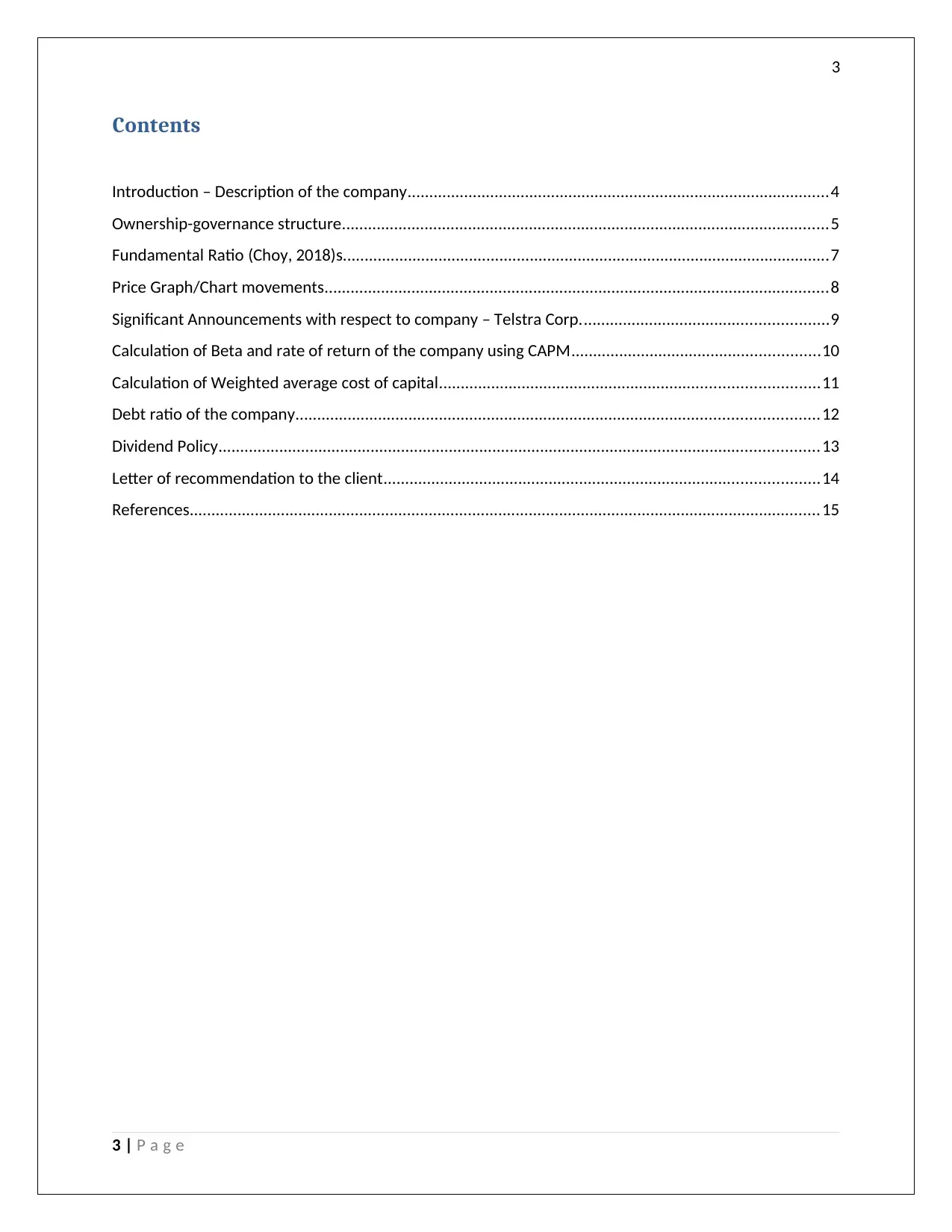
3
Contents
Introduction – Description of the company.................................................................................................4
Ownership-governance structure................................................................................................................5
Fundamental Ratio (Choy, 2018)s................................................................................................................7
Price Graph/Chart movements....................................................................................................................8
Significant Announcements with respect to company – Telstra Corp.........................................................9
Calculation of Beta and rate of return of the company using CAPM.........................................................10
Calculation of Weighted average cost of capital.......................................................................................11
Debt ratio of the company........................................................................................................................12
Dividend Policy..........................................................................................................................................13
Letter of recommendation to the client....................................................................................................14
References.................................................................................................................................................15
3 | P a g e
Contents
Introduction – Description of the company.................................................................................................4
Ownership-governance structure................................................................................................................5
Fundamental Ratio (Choy, 2018)s................................................................................................................7
Price Graph/Chart movements....................................................................................................................8
Significant Announcements with respect to company – Telstra Corp.........................................................9
Calculation of Beta and rate of return of the company using CAPM.........................................................10
Calculation of Weighted average cost of capital.......................................................................................11
Debt ratio of the company........................................................................................................................12
Dividend Policy..........................................................................................................................................13
Letter of recommendation to the client....................................................................................................14
References.................................................................................................................................................15
3 | P a g e
Paraphrase This Document
Need a fresh take? Get an instant paraphrase of this document with our AI Paraphraser
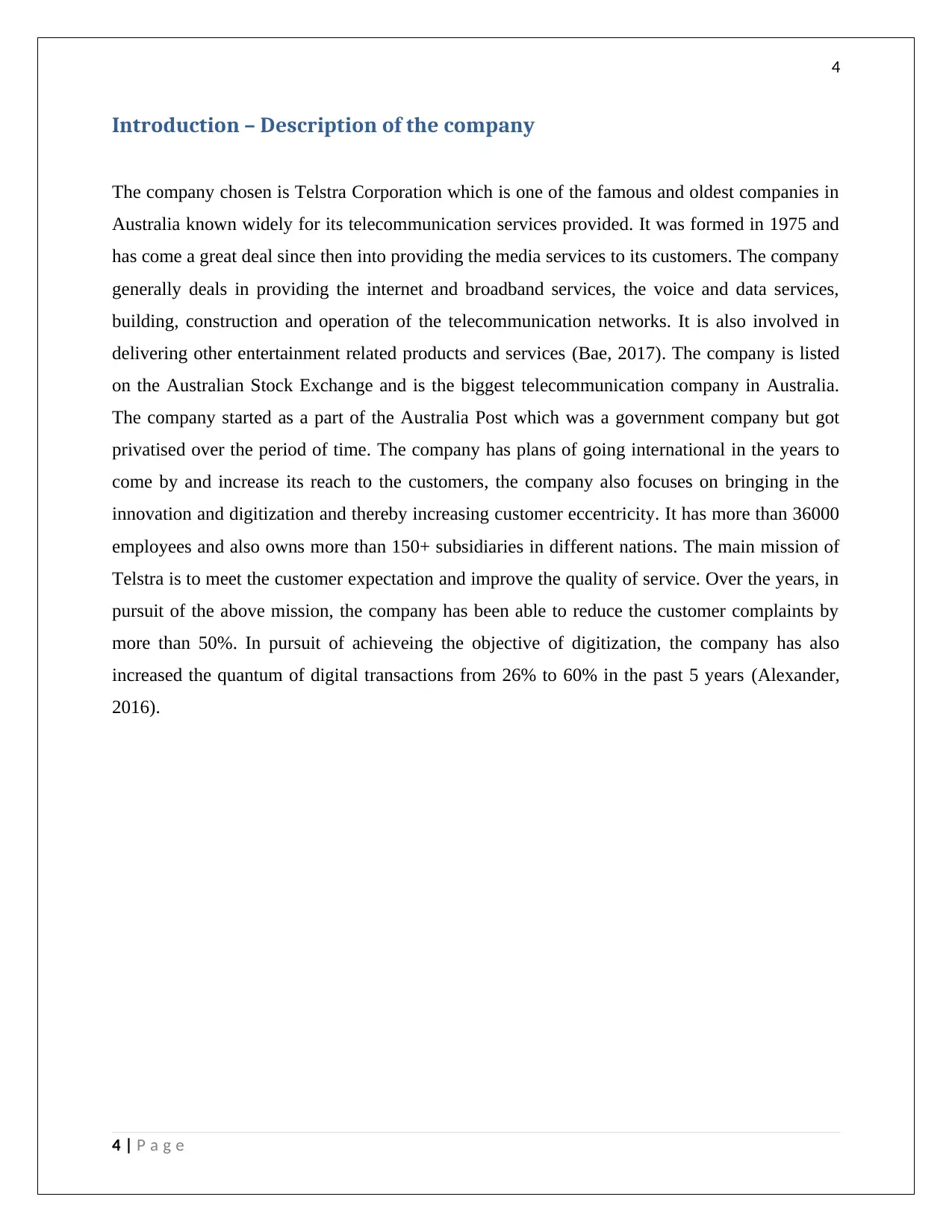
4
Introduction – Description of the company
The company chosen is Telstra Corporation which is one of the famous and oldest companies in
Australia known widely for its telecommunication services provided. It was formed in 1975 and
has come a great deal since then into providing the media services to its customers. The company
generally deals in providing the internet and broadband services, the voice and data services,
building, construction and operation of the telecommunication networks. It is also involved in
delivering other entertainment related products and services (Bae, 2017). The company is listed
on the Australian Stock Exchange and is the biggest telecommunication company in Australia.
The company started as a part of the Australia Post which was a government company but got
privatised over the period of time. The company has plans of going international in the years to
come by and increase its reach to the customers, the company also focuses on bringing in the
innovation and digitization and thereby increasing customer eccentricity. It has more than 36000
employees and also owns more than 150+ subsidiaries in different nations. The main mission of
Telstra is to meet the customer expectation and improve the quality of service. Over the years, in
pursuit of the above mission, the company has been able to reduce the customer complaints by
more than 50%. In pursuit of achieveing the objective of digitization, the company has also
increased the quantum of digital transactions from 26% to 60% in the past 5 years (Alexander,
2016).
4 | P a g e
Introduction – Description of the company
The company chosen is Telstra Corporation which is one of the famous and oldest companies in
Australia known widely for its telecommunication services provided. It was formed in 1975 and
has come a great deal since then into providing the media services to its customers. The company
generally deals in providing the internet and broadband services, the voice and data services,
building, construction and operation of the telecommunication networks. It is also involved in
delivering other entertainment related products and services (Bae, 2017). The company is listed
on the Australian Stock Exchange and is the biggest telecommunication company in Australia.
The company started as a part of the Australia Post which was a government company but got
privatised over the period of time. The company has plans of going international in the years to
come by and increase its reach to the customers, the company also focuses on bringing in the
innovation and digitization and thereby increasing customer eccentricity. It has more than 36000
employees and also owns more than 150+ subsidiaries in different nations. The main mission of
Telstra is to meet the customer expectation and improve the quality of service. Over the years, in
pursuit of the above mission, the company has been able to reduce the customer complaints by
more than 50%. In pursuit of achieveing the objective of digitization, the company has also
increased the quantum of digital transactions from 26% to 60% in the past 5 years (Alexander,
2016).
4 | P a g e
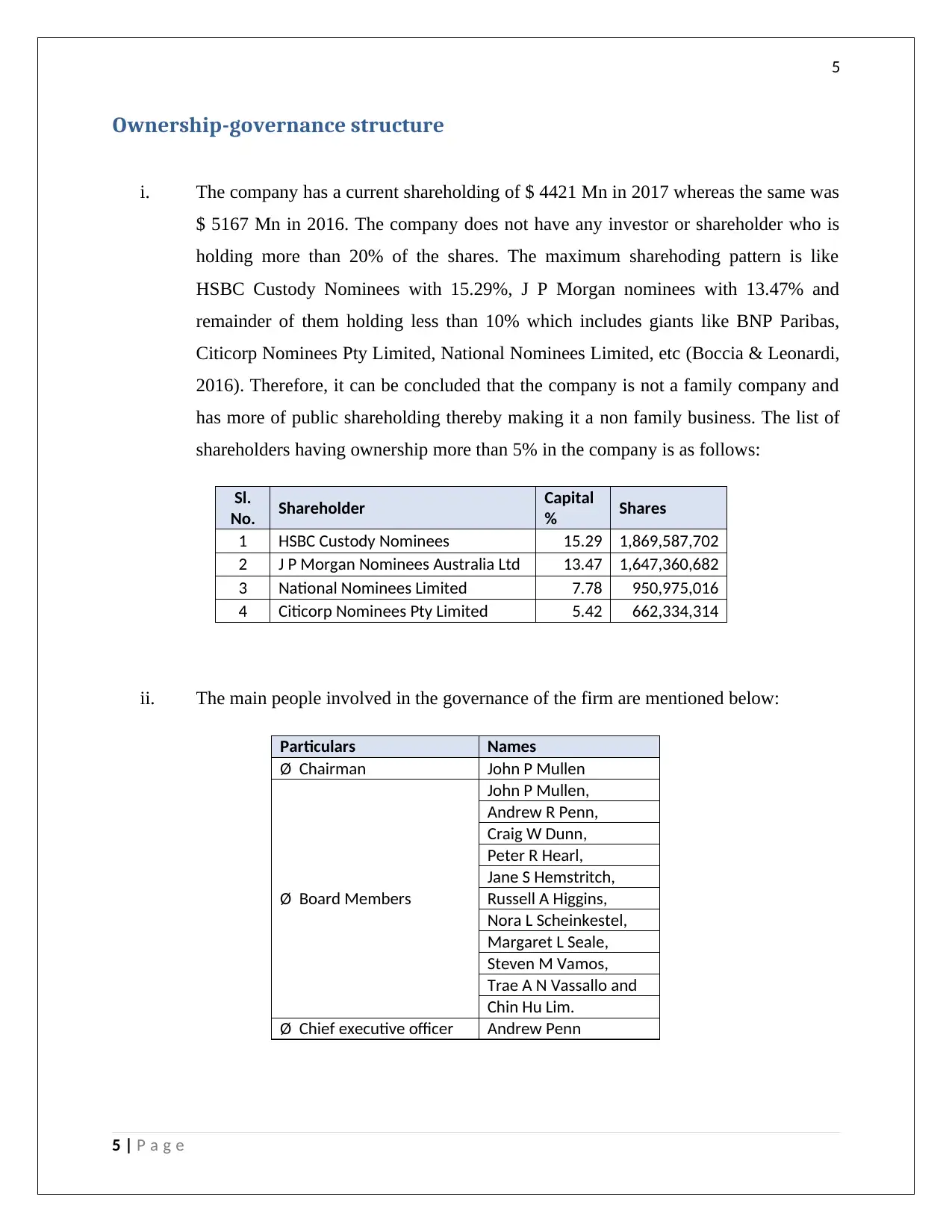
5
Ownership-governance structure
i. The company has a current shareholding of $ 4421 Mn in 2017 whereas the same was
$ 5167 Mn in 2016. The company does not have any investor or shareholder who is
holding more than 20% of the shares. The maximum sharehoding pattern is like
HSBC Custody Nominees with 15.29%, J P Morgan nominees with 13.47% and
remainder of them holding less than 10% which includes giants like BNP Paribas,
Citicorp Nominees Pty Limited, National Nominees Limited, etc (Boccia & Leonardi,
2016). Therefore, it can be concluded that the company is not a family company and
has more of public shareholding thereby making it a non family business. The list of
shareholders having ownership more than 5% in the company is as follows:
Sl.
No. Shareholder Capital
% Shares
1 HSBC Custody Nominees 15.29 1,869,587,702
2 J P Morgan Nominees Australia Ltd 13.47 1,647,360,682
3 National Nominees Limited 7.78 950,975,016
4 Citicorp Nominees Pty Limited 5.42 662,334,314
ii. The main people involved in the governance of the firm are mentioned below:
Particulars Names
Ø Chairman John P Mullen
Ø Board Members
John P Mullen,
Andrew R Penn,
Craig W Dunn,
Peter R Hearl,
Jane S Hemstritch,
Russell A Higgins,
Nora L Scheinkestel,
Margaret L Seale,
Steven M Vamos,
Trae A N Vassallo and
Chin Hu Lim.
Ø Chief executive officer Andrew Penn
5 | P a g e
Ownership-governance structure
i. The company has a current shareholding of $ 4421 Mn in 2017 whereas the same was
$ 5167 Mn in 2016. The company does not have any investor or shareholder who is
holding more than 20% of the shares. The maximum sharehoding pattern is like
HSBC Custody Nominees with 15.29%, J P Morgan nominees with 13.47% and
remainder of them holding less than 10% which includes giants like BNP Paribas,
Citicorp Nominees Pty Limited, National Nominees Limited, etc (Boccia & Leonardi,
2016). Therefore, it can be concluded that the company is not a family company and
has more of public shareholding thereby making it a non family business. The list of
shareholders having ownership more than 5% in the company is as follows:
Sl.
No. Shareholder Capital
% Shares
1 HSBC Custody Nominees 15.29 1,869,587,702
2 J P Morgan Nominees Australia Ltd 13.47 1,647,360,682
3 National Nominees Limited 7.78 950,975,016
4 Citicorp Nominees Pty Limited 5.42 662,334,314
ii. The main people involved in the governance of the firm are mentioned below:
Particulars Names
Ø Chairman John P Mullen
Ø Board Members
John P Mullen,
Andrew R Penn,
Craig W Dunn,
Peter R Hearl,
Jane S Hemstritch,
Russell A Higgins,
Nora L Scheinkestel,
Margaret L Seale,
Steven M Vamos,
Trae A N Vassallo and
Chin Hu Lim.
Ø Chief executive officer Andrew Penn
5 | P a g e
⊘ This is a preview!⊘
Do you want full access?
Subscribe today to unlock all pages.

Trusted by 1+ million students worldwide
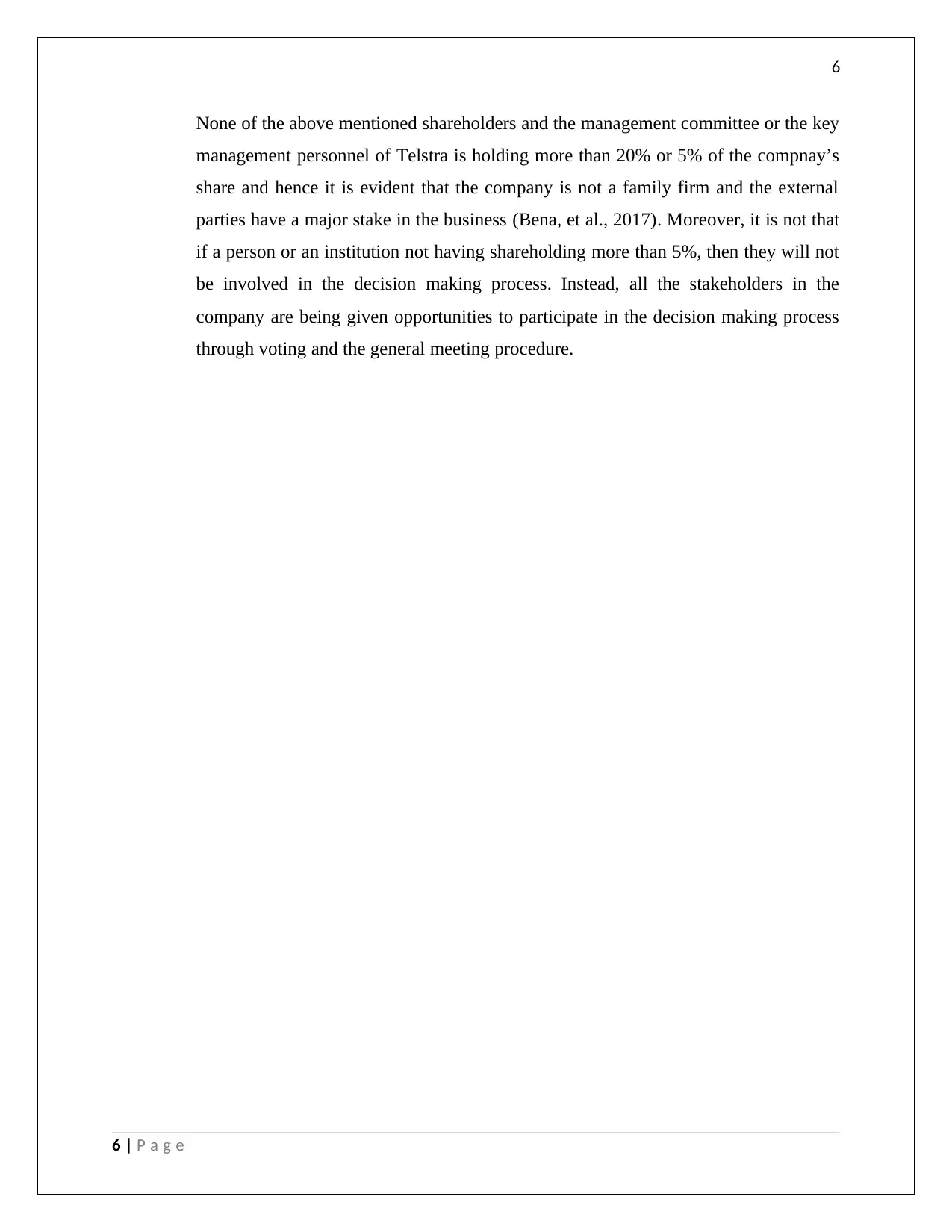
6
None of the above mentioned shareholders and the management committee or the key
management personnel of Telstra is holding more than 20% or 5% of the compnay’s
share and hence it is evident that the company is not a family firm and the external
parties have a major stake in the business (Bena, et al., 2017). Moreover, it is not that
if a person or an institution not having shareholding more than 5%, then they will not
be involved in the decision making process. Instead, all the stakeholders in the
company are being given opportunities to participate in the decision making process
through voting and the general meeting procedure.
6 | P a g e
None of the above mentioned shareholders and the management committee or the key
management personnel of Telstra is holding more than 20% or 5% of the compnay’s
share and hence it is evident that the company is not a family firm and the external
parties have a major stake in the business (Bena, et al., 2017). Moreover, it is not that
if a person or an institution not having shareholding more than 5%, then they will not
be involved in the decision making process. Instead, all the stakeholders in the
company are being given opportunities to participate in the decision making process
through voting and the general meeting procedure.
6 | P a g e
Paraphrase This Document
Need a fresh take? Get an instant paraphrase of this document with our AI Paraphraser
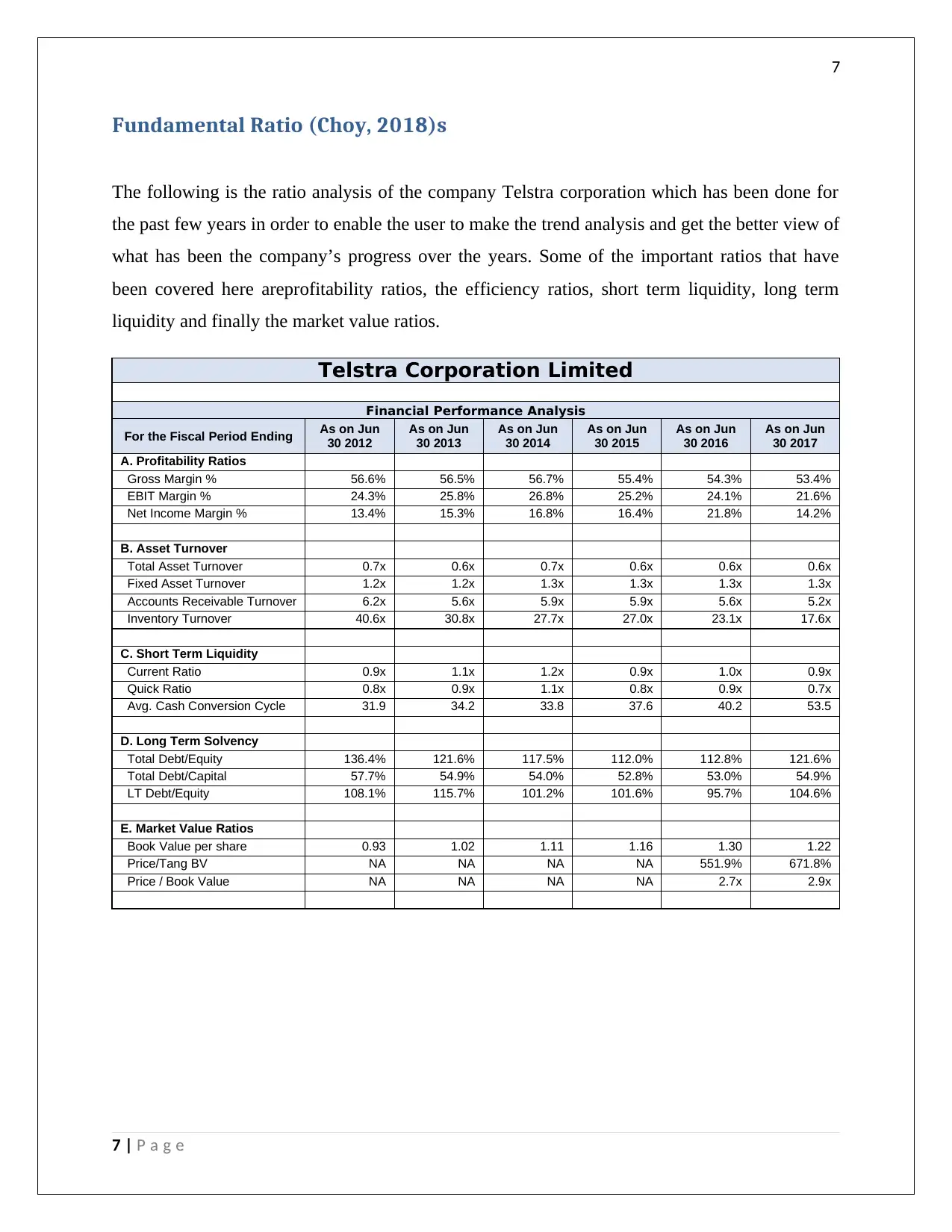
7
Fundamental Ratio (Choy, 2018)s
The following is the ratio analysis of the company Telstra corporation which has been done for
the past few years in order to enable the user to make the trend analysis and get the better view of
what has been the company’s progress over the years. Some of the important ratios that have
been covered here areprofitability ratios, the efficiency ratios, short term liquidity, long term
liquidity and finally the market value ratios.
Telstra Corporation Limited
Financial Performance Analysis
For the Fiscal Period Ending As on Jun
30 2012
As on Jun
30 2013
As on Jun
30 2014
As on Jun
30 2015
As on Jun
30 2016
As on Jun
30 2017
A. Profitability Ratios
Gross Margin % 56.6% 56.5% 56.7% 55.4% 54.3% 53.4%
EBIT Margin % 24.3% 25.8% 26.8% 25.2% 24.1% 21.6%
Net Income Margin % 13.4% 15.3% 16.8% 16.4% 21.8% 14.2%
B. Asset Turnover
Total Asset Turnover 0.7x 0.6x 0.7x 0.6x 0.6x 0.6x
Fixed Asset Turnover 1.2x 1.2x 1.3x 1.3x 1.3x 1.3x
Accounts Receivable Turnover 6.2x 5.6x 5.9x 5.9x 5.6x 5.2x
Inventory Turnover 40.6x 30.8x 27.7x 27.0x 23.1x 17.6x
C. Short Term Liquidity
Current Ratio 0.9x 1.1x 1.2x 0.9x 1.0x 0.9x
Quick Ratio 0.8x 0.9x 1.1x 0.8x 0.9x 0.7x
Avg. Cash Conversion Cycle 31.9 34.2 33.8 37.6 40.2 53.5
D. Long Term Solvency
Total Debt/Equity 136.4% 121.6% 117.5% 112.0% 112.8% 121.6%
Total Debt/Capital 57.7% 54.9% 54.0% 52.8% 53.0% 54.9%
LT Debt/Equity 108.1% 115.7% 101.2% 101.6% 95.7% 104.6%
E. Market Value Ratios
Book Value per share 0.93 1.02 1.11 1.16 1.30 1.22
Price/Tang BV NA NA NA NA 551.9% 671.8%
Price / Book Value NA NA NA NA 2.7x 2.9x
7 | P a g e
Fundamental Ratio (Choy, 2018)s
The following is the ratio analysis of the company Telstra corporation which has been done for
the past few years in order to enable the user to make the trend analysis and get the better view of
what has been the company’s progress over the years. Some of the important ratios that have
been covered here areprofitability ratios, the efficiency ratios, short term liquidity, long term
liquidity and finally the market value ratios.
Telstra Corporation Limited
Financial Performance Analysis
For the Fiscal Period Ending As on Jun
30 2012
As on Jun
30 2013
As on Jun
30 2014
As on Jun
30 2015
As on Jun
30 2016
As on Jun
30 2017
A. Profitability Ratios
Gross Margin % 56.6% 56.5% 56.7% 55.4% 54.3% 53.4%
EBIT Margin % 24.3% 25.8% 26.8% 25.2% 24.1% 21.6%
Net Income Margin % 13.4% 15.3% 16.8% 16.4% 21.8% 14.2%
B. Asset Turnover
Total Asset Turnover 0.7x 0.6x 0.7x 0.6x 0.6x 0.6x
Fixed Asset Turnover 1.2x 1.2x 1.3x 1.3x 1.3x 1.3x
Accounts Receivable Turnover 6.2x 5.6x 5.9x 5.9x 5.6x 5.2x
Inventory Turnover 40.6x 30.8x 27.7x 27.0x 23.1x 17.6x
C. Short Term Liquidity
Current Ratio 0.9x 1.1x 1.2x 0.9x 1.0x 0.9x
Quick Ratio 0.8x 0.9x 1.1x 0.8x 0.9x 0.7x
Avg. Cash Conversion Cycle 31.9 34.2 33.8 37.6 40.2 53.5
D. Long Term Solvency
Total Debt/Equity 136.4% 121.6% 117.5% 112.0% 112.8% 121.6%
Total Debt/Capital 57.7% 54.9% 54.0% 52.8% 53.0% 54.9%
LT Debt/Equity 108.1% 115.7% 101.2% 101.6% 95.7% 104.6%
E. Market Value Ratios
Book Value per share 0.93 1.02 1.11 1.16 1.30 1.22
Price/Tang BV NA NA NA NA 551.9% 671.8%
Price / Book Value NA NA NA NA 2.7x 2.9x
7 | P a g e
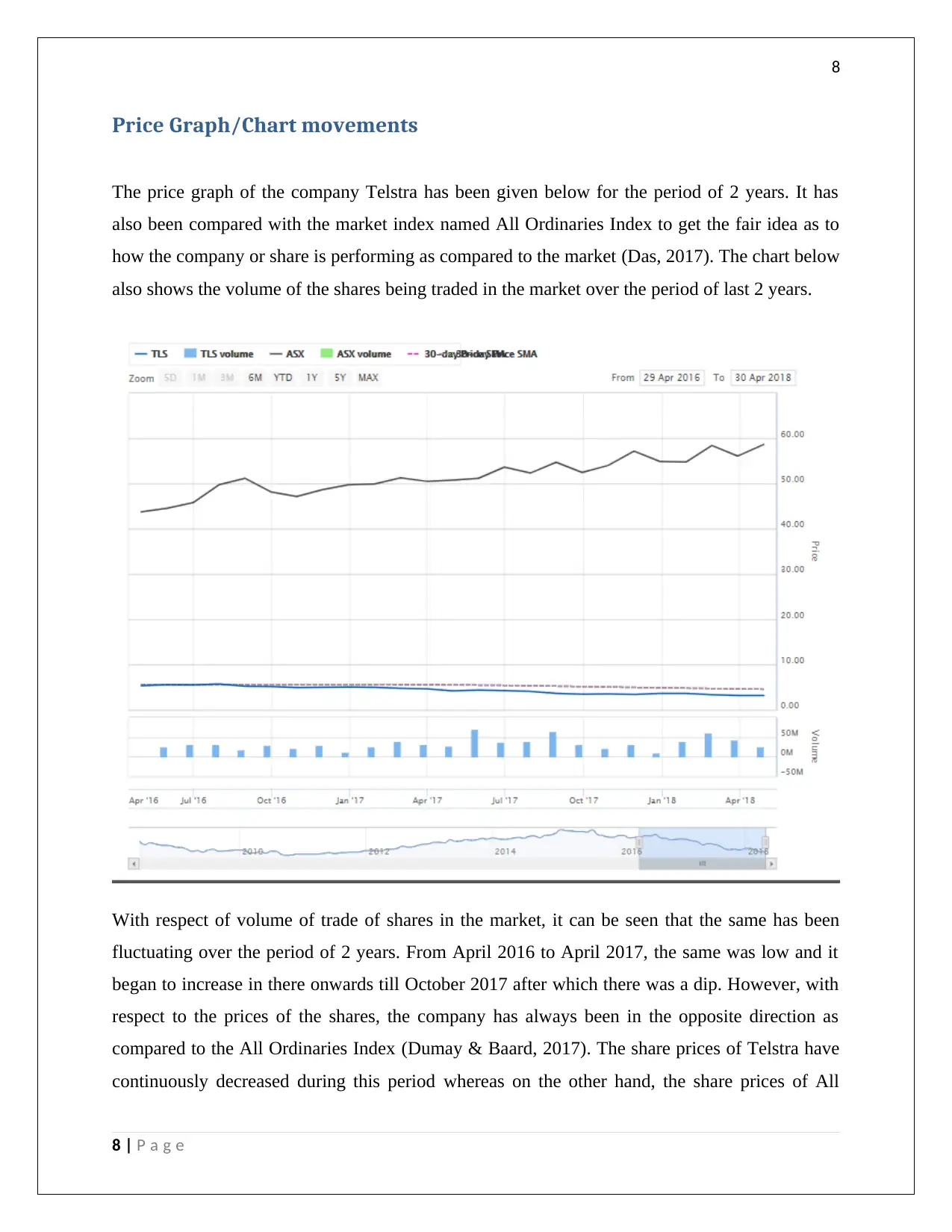
8
Price Graph/Chart movements
The price graph of the company Telstra has been given below for the period of 2 years. It has
also been compared with the market index named All Ordinaries Index to get the fair idea as to
how the company or share is performing as compared to the market (Das, 2017). The chart below
also shows the volume of the shares being traded in the market over the period of last 2 years.
With respect of volume of trade of shares in the market, it can be seen that the same has been
fluctuating over the period of 2 years. From April 2016 to April 2017, the same was low and it
began to increase in there onwards till October 2017 after which there was a dip. However, with
respect to the prices of the shares, the company has always been in the opposite direction as
compared to the All Ordinaries Index (Dumay & Baard, 2017). The share prices of Telstra have
continuously decreased during this period whereas on the other hand, the share prices of All
8 | P a g e
Price Graph/Chart movements
The price graph of the company Telstra has been given below for the period of 2 years. It has
also been compared with the market index named All Ordinaries Index to get the fair idea as to
how the company or share is performing as compared to the market (Das, 2017). The chart below
also shows the volume of the shares being traded in the market over the period of last 2 years.
With respect of volume of trade of shares in the market, it can be seen that the same has been
fluctuating over the period of 2 years. From April 2016 to April 2017, the same was low and it
began to increase in there onwards till October 2017 after which there was a dip. However, with
respect to the prices of the shares, the company has always been in the opposite direction as
compared to the All Ordinaries Index (Dumay & Baard, 2017). The share prices of Telstra have
continuously decreased during this period whereas on the other hand, the share prices of All
8 | P a g e
⊘ This is a preview!⊘
Do you want full access?
Subscribe today to unlock all pages.

Trusted by 1+ million students worldwide
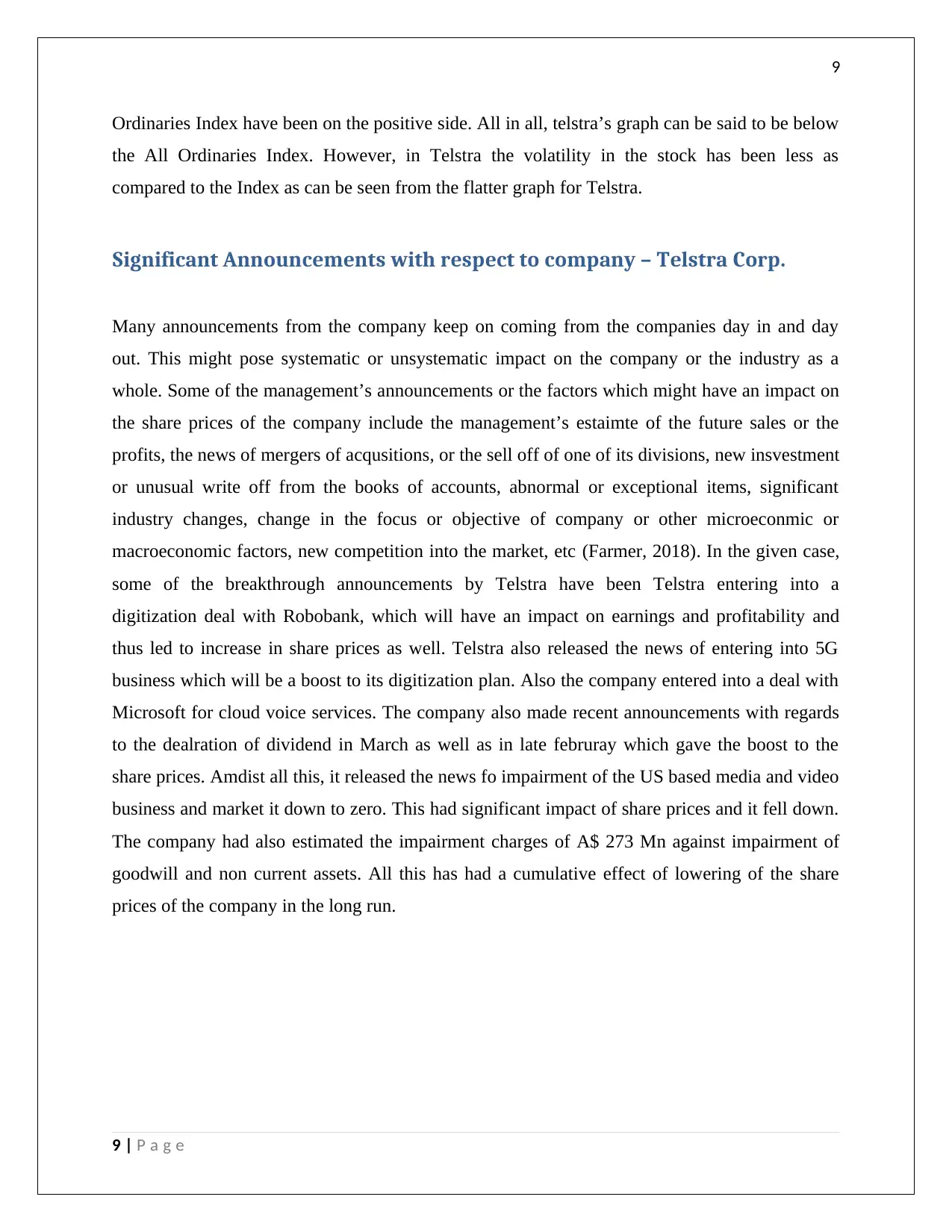
9
Ordinaries Index have been on the positive side. All in all, telstra’s graph can be said to be below
the All Ordinaries Index. However, in Telstra the volatility in the stock has been less as
compared to the Index as can be seen from the flatter graph for Telstra.
Significant Announcements with respect to company – Telstra Corp.
Many announcements from the company keep on coming from the companies day in and day
out. This might pose systematic or unsystematic impact on the company or the industry as a
whole. Some of the management’s announcements or the factors which might have an impact on
the share prices of the company include the management’s estaimte of the future sales or the
profits, the news of mergers of acqusitions, or the sell off of one of its divisions, new insvestment
or unusual write off from the books of accounts, abnormal or exceptional items, significant
industry changes, change in the focus or objective of company or other microeconmic or
macroeconomic factors, new competition into the market, etc (Farmer, 2018). In the given case,
some of the breakthrough announcements by Telstra have been Telstra entering into a
digitization deal with Robobank, which will have an impact on earnings and profitability and
thus led to increase in share prices as well. Telstra also released the news of entering into 5G
business which will be a boost to its digitization plan. Also the company entered into a deal with
Microsoft for cloud voice services. The company also made recent announcements with regards
to the dealration of dividend in March as well as in late februray which gave the boost to the
share prices. Amdist all this, it released the news fo impairment of the US based media and video
business and market it down to zero. This had significant impact of share prices and it fell down.
The company had also estimated the impairment charges of A$ 273 Mn against impairment of
goodwill and non current assets. All this has had a cumulative effect of lowering of the share
prices of the company in the long run.
9 | P a g e
Ordinaries Index have been on the positive side. All in all, telstra’s graph can be said to be below
the All Ordinaries Index. However, in Telstra the volatility in the stock has been less as
compared to the Index as can be seen from the flatter graph for Telstra.
Significant Announcements with respect to company – Telstra Corp.
Many announcements from the company keep on coming from the companies day in and day
out. This might pose systematic or unsystematic impact on the company or the industry as a
whole. Some of the management’s announcements or the factors which might have an impact on
the share prices of the company include the management’s estaimte of the future sales or the
profits, the news of mergers of acqusitions, or the sell off of one of its divisions, new insvestment
or unusual write off from the books of accounts, abnormal or exceptional items, significant
industry changes, change in the focus or objective of company or other microeconmic or
macroeconomic factors, new competition into the market, etc (Farmer, 2018). In the given case,
some of the breakthrough announcements by Telstra have been Telstra entering into a
digitization deal with Robobank, which will have an impact on earnings and profitability and
thus led to increase in share prices as well. Telstra also released the news of entering into 5G
business which will be a boost to its digitization plan. Also the company entered into a deal with
Microsoft for cloud voice services. The company also made recent announcements with regards
to the dealration of dividend in March as well as in late februray which gave the boost to the
share prices. Amdist all this, it released the news fo impairment of the US based media and video
business and market it down to zero. This had significant impact of share prices and it fell down.
The company had also estimated the impairment charges of A$ 273 Mn against impairment of
goodwill and non current assets. All this has had a cumulative effect of lowering of the share
prices of the company in the long run.
9 | P a g e
Paraphrase This Document
Need a fresh take? Get an instant paraphrase of this document with our AI Paraphraser
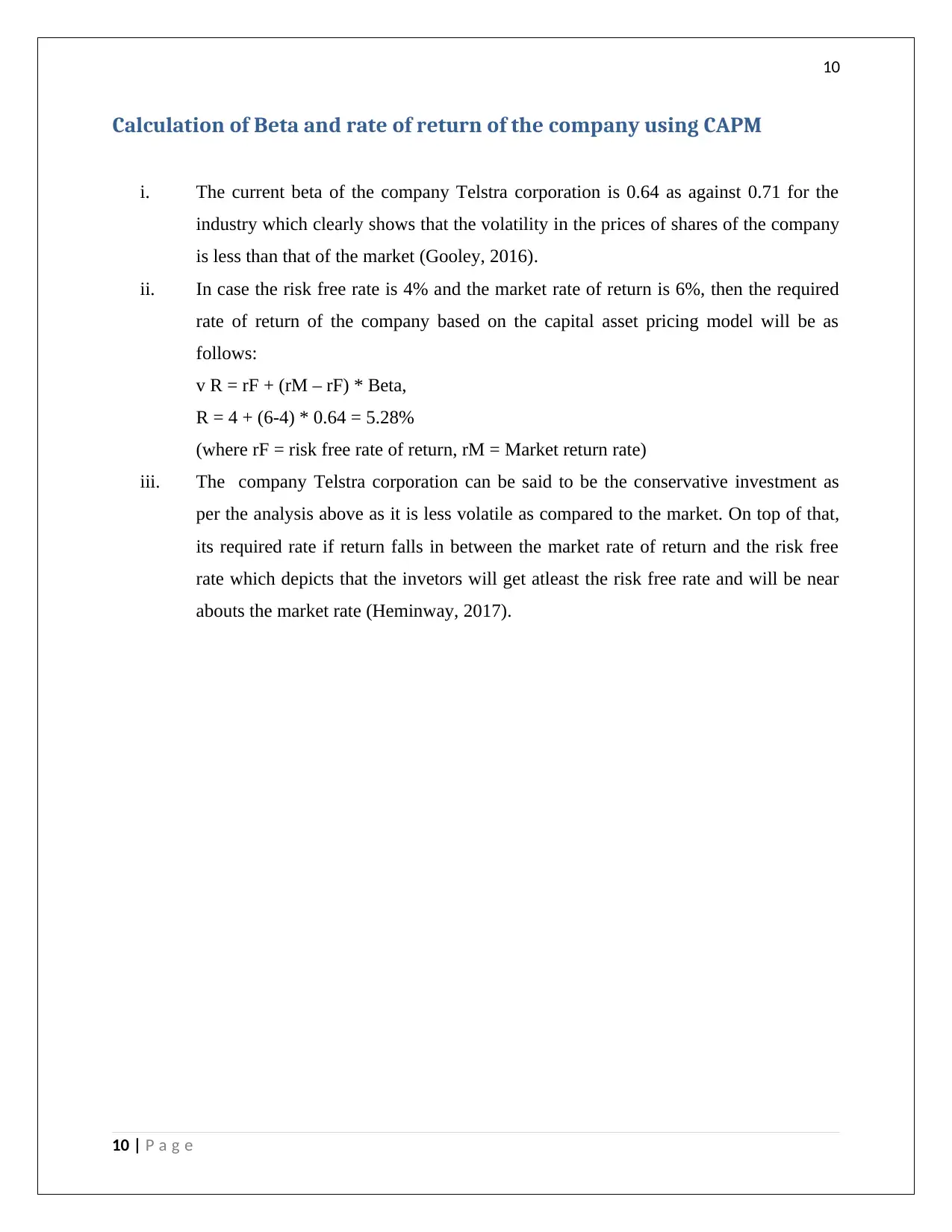
10
Calculation of Beta and rate of return of the company using CAPM
i. The current beta of the company Telstra corporation is 0.64 as against 0.71 for the
industry which clearly shows that the volatility in the prices of shares of the company
is less than that of the market (Gooley, 2016).
ii. In case the risk free rate is 4% and the market rate of return is 6%, then the required
rate of return of the company based on the capital asset pricing model will be as
follows:
v R = rF + (rM – rF) * Beta,
R = 4 + (6-4) * 0.64 = 5.28%
(where rF = risk free rate of return, rM = Market return rate)
iii. The company Telstra corporation can be said to be the conservative investment as
per the analysis above as it is less volatile as compared to the market. On top of that,
its required rate if return falls in between the market rate of return and the risk free
rate which depicts that the invetors will get atleast the risk free rate and will be near
abouts the market rate (Heminway, 2017).
10 | P a g e
Calculation of Beta and rate of return of the company using CAPM
i. The current beta of the company Telstra corporation is 0.64 as against 0.71 for the
industry which clearly shows that the volatility in the prices of shares of the company
is less than that of the market (Gooley, 2016).
ii. In case the risk free rate is 4% and the market rate of return is 6%, then the required
rate of return of the company based on the capital asset pricing model will be as
follows:
v R = rF + (rM – rF) * Beta,
R = 4 + (6-4) * 0.64 = 5.28%
(where rF = risk free rate of return, rM = Market return rate)
iii. The company Telstra corporation can be said to be the conservative investment as
per the analysis above as it is less volatile as compared to the market. On top of that,
its required rate if return falls in between the market rate of return and the risk free
rate which depicts that the invetors will get atleast the risk free rate and will be near
abouts the market rate (Heminway, 2017).
10 | P a g e

11
Calculation of Weighted average cost of capital
i. The weighted average average cost of capital od the company as per the required rate
of return calculated above and the inputs given in the annual report have been shown
below:
Telstra Corporation Limited
Calculation of Weighted average cost of capital
Particulars Amount Proportion Interest Rate Weighted Average
Amount of Debt in total capital 17703 54.90% 5.10% 2.80%
Amount of Equity in total capital 14560 45.10% 5.28% 2.38%
Total capital 32263 100.00%
Weighted Average cost of capital 5.18%
ii. Higher WACC will alaways be an issue with the company as it mentions the higher
cost of capital procurement. Furthermore, it will cause even more issue when the
company has plans of expansion and prospective investment. It reflects the average
cost for both the debt as well as the equity. In other words, it is the opportunity cost of
taking the risk of going ahead with the investment in the company. Higher the
WACC, higher the risk involved (Goldmann, 2016). And therefore more is the
expectation of the returns. This is a sum total of cost of debt financing and equity
financing, interest cost and requisite rate of return for equity shareholders. In case
of prospective investments, if the costs are higher, then the return and savings would
be lower. Finally, it may also have an impact in the form of falling share prices and
thus, the cost of capital needs to be planned well.
11 | P a g e
Calculation of Weighted average cost of capital
i. The weighted average average cost of capital od the company as per the required rate
of return calculated above and the inputs given in the annual report have been shown
below:
Telstra Corporation Limited
Calculation of Weighted average cost of capital
Particulars Amount Proportion Interest Rate Weighted Average
Amount of Debt in total capital 17703 54.90% 5.10% 2.80%
Amount of Equity in total capital 14560 45.10% 5.28% 2.38%
Total capital 32263 100.00%
Weighted Average cost of capital 5.18%
ii. Higher WACC will alaways be an issue with the company as it mentions the higher
cost of capital procurement. Furthermore, it will cause even more issue when the
company has plans of expansion and prospective investment. It reflects the average
cost for both the debt as well as the equity. In other words, it is the opportunity cost of
taking the risk of going ahead with the investment in the company. Higher the
WACC, higher the risk involved (Goldmann, 2016). And therefore more is the
expectation of the returns. This is a sum total of cost of debt financing and equity
financing, interest cost and requisite rate of return for equity shareholders. In case
of prospective investments, if the costs are higher, then the return and savings would
be lower. Finally, it may also have an impact in the form of falling share prices and
thus, the cost of capital needs to be planned well.
11 | P a g e
⊘ This is a preview!⊘
Do you want full access?
Subscribe today to unlock all pages.

Trusted by 1+ million students worldwide
1 out of 17
Related Documents
Your All-in-One AI-Powered Toolkit for Academic Success.
+13062052269
info@desklib.com
Available 24*7 on WhatsApp / Email
![[object Object]](/_next/static/media/star-bottom.7253800d.svg)
Unlock your academic potential
Copyright © 2020–2025 A2Z Services. All Rights Reserved. Developed and managed by ZUCOL.




